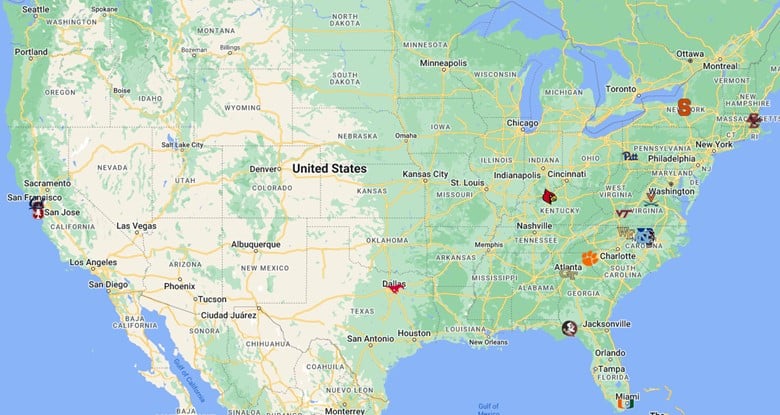The tectonic plates of college football are shifting, and at the epicenter is the ACC (Atlantic Coast Conference). Embarking on a westward journey, the ACC welcomes Stanford, California (Cal), and SMU into its embrace. A quick glance at the map reveals that the ACC is not just redefining boundaries but forging a path to an era of cross-country football. Check out how the new ACC map will look below.
Overview of ACC’s New Landscape
If we anchor our attention on the map, it’s evident that the ACC, predominantly an East Coast stronghold, is now casting its net far and wide. From the storied grounds of Miami and the Tobacco Road in North Carolina to the cultural mosaic of Boston, and now stretching to the golden terrains of Northern California – the ACC is reimagining college football geography.
- BC to Cal & Stanford: Drawing a line on the map from Boston College in Chestnut Hill, Massachusetts to the University of California, the distance is a whopping 2,670 miles. Extend that line a tad bit further to Stanford, CA, and it’s roughly 2,680 miles. As you can see from the map, this isn’t just a minor geographical adjustment – it’s a monumental leap across the country.
- Notre Dame & Louisville’s New Western Neighbors: Previously, Notre Dame (basketball only) in South Bend, Indiana and Louisville held the mantle as the western frontiers of the ACC. But with Cal and Stanford in the mix, the map showcases the ACC’s ambitious cross-country endeavor.
Navigating the New Terrains
As intriguing as the map looks with its widened purview, there are real-world implications to consider:
- Distance & Time Zones: Besides the sheer physical distance and long flights, there’s the unavoidable factor of time zones. An evening game on the West Coast starts three hours later on the East Coast, potentially affecting TV schedules and viewership.
- Logistical Challenges: The prospect of teams and fans traversing these long distances introduces a myriad of challenges. As you can see from the map, journeying from Boston to either Berkeley or Stanford involves cross-country flights of around 6 hours, not accounting for other travel nitty-gritty.
- Strains on Student-Athletes: The map might make the ACC look unified, but for student-athletes, it translates to grueling travels and potential fatigue, especially for sports that demand frequent matches.
Mapping the Way Forward
The new ACC map represents more than just dots and lines; it’s a commitment to integration and a shared vision. Each school, old or new, carries with it a legacy, a cultural ethos, and a passion for sports.
For the Bay Area schools, this map charts a new direction, providing solace amidst the turbulence of the Pac-12. For SMU, the ACC map is a beacon, guiding them back to the limelight of major conference football.
As you can see from the map, and as Carol Christ, University of California-Berkeley Chancellor aptly put it, the ACC’s diverse tapestry of institutions promises an “elite competitive context for our student-athletes in this changing landscape of intercollegiate athletics.”
Could the new ACC geographical realignment signify the future of college football?
College Football Betting Guides 2024
- College Football Betting Guide – Best NCAAF Sportsbooks Ranked & Reviewed.
- Free NCAAF Picks – Check out Expert College Football Picks.
- The Latest NCAAF Odds – Compare the Best College Football Odds.
- College Football Moneyline Odds Explained – Learn How To Win NCAAF Moneyline Bets.
- College Football Spreads Explained – Guide on How To Win NCAAF Spreads Bets.
- College Football Futures Odds Explained – Expert Guide on How to Win NCAAF Spread Bets.
- College Football Totals Odds Explained – Guide on How to Win College Football Totals Bets.
Add The Sports Daily to your Google News Feed!







